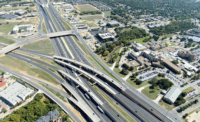Best Road/Highway - LBJ Express

PHOTO COURTESY OF FERROVIAL AGROMAN

PHOTO COURTESY OF FERROVIAL AGROMAN

PHOTO COURTESY OF FERROVIAL AGROMAN



LBJ Express
Dallas
Best Project
Owners LBJ Infrastructure Group; Texas Dept. of Transportation (TxDOT)
Contractor, Lead Designer Trinity Infrastructure, a joint venture of Ferrovial Agroman US and Webber
Consultants Janssen and Spaans; Bridgefarmer; Terracon; Fugro
The new LBJ Express, a 13-mile-long, $2.7-billion P3 project, crosses two municipalities within Dallas County, Texas, and doubles the existing capacity of the highway corridor, one of the busiest in the nation.
Trinity Infrastructure, a joint venture between Ferrovial Agroman US and Webber, led the design and construction on the project, which was the county’s first comprehensive development agreement. LBJ Infrastructure Group, an owner of the project, is a consortium of Cintra, Meridiam Infrastructure and the Dallas Police and Fire Pension System.
Reconstruction included two major interchanges—IH 35E and the Dallas North Tollway—as well as 12 arterial crossings, six collector street crossings and one pedestrian walkway crossing. Additionally, more than 6 million cu yd of material were excavated, 5.8 million sq ft of bridge decks were built, and approximately 2 million sq ft of retaining walls were constructed, all while maintaining mobility for 250,000 motorists coursing through the corridor daily.
A team of more than 9,000 workers clocked 18 million hours, with a 1.2 safety incident rate and no life-threatening injuries or fatalities. Before reporting to work, all employees and subcontracted workers were required to attend a four-hour safety and environmental orientation that specifically addressed traffic hazards and working around traffic safely, says Luis Muñoz, Trinity Infrastructure CEO.
The project began in late 2010 and was completed on budget and three months ahead of schedule.
“An accelerated schedule and design-build concept allowed for the project to be completed a decade ahead of the traditional construction methods,” Muñoz notes. “Redesigns allowed in the design-build contract helped to bring the job in early. Continuous communication and managing the day-to-day logistics with TxDOT and more than 250-plus companies working on the project was the key difference maker.”
The project was divided geographically into three construction segments and then subsegments, which sped up the construction schedule and allowed all 13 miles to be under construction simultaneously, Muñoz adds.
Among numerous challenges, the teams had to acquire right-of-way across the project’s footprint, tackling 223 conflicts and more than 226 million linear ft of utilities.
“We did have difficulties in finding resources for certain trades, mostly due to the large amount of construction being done in the Dallas-Fort Worth area at the same time,” adds Tim Creson, CEO of Webber. “We worked to create precast facilities near the corridor to increase the supply of materials. This helped with supply of caps, beams and deck panels.”
During construction, certain bridges had to be built first, which meant that lower structures had to be constructed with greatly reduced vertical clearance, adds Muñoz.
“The construction of the managed-lanes cantilever decks constituted the critical path of the project. Therefore, the ability to resolve these decks [was] of key importance for the overall outcome of the project,” Munoz says. “A custom-built, 285-ft-span steel-truss system was engineered and manufactured off-site with high-strength steel using a combination of pretensioned bolts and welding. The beam-setting device let the [team] construct the affected superstructures in a short duration, without extra earthworks or a retaining-wall complete redesign.”
Since the corridor opened in September 2015, traffic has increased by more than 15% while congestion has been reduced by 60%, notes Alberto Gonzalez, CEO of LBJ Infrastructure Group.






